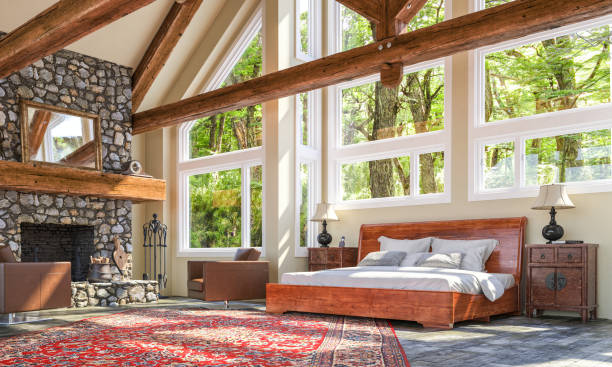The farmhouse style has emerged as a timeless and beloved interior design trend, known for its warmth, simplicity, and rustic charm. A key element in achieving the quintessential farmhouse look is selecting the right rugs, incorporating thoughtful design, and blending cohesive décor elements. In this comprehensive guide, we’ll explore the essence of farmhouse-style rugs, delve into design principles, and provide practical tips for creating an inviting farmhouse-inspired space.
Characteristics of Farmhouse Style Rugs:
Farmhouse-style rugs play a pivotal role in setting the tone for the entire aesthetic of a room. To capture the essence of this design trend, consider the following characteristics when choosing rugs:
a. Neutral Colors:
Opt for rugs in neutral tones such as beige, cream, or soft gray. These colors create a serene and calming atmosphere, aligning with the farmhouse ethos of simplicity and understated elegance.
b. Natural Fibers:
Embrace natural materials like jute, sisal, or cotton for your farmhouse rugs. These fibers not only contribute to the earthy and organic feel but also align with the practical and useful aspects of farmhouse living.
c. Subtle Patterns:
Choose rugs with subtle and classic patterns such as stripes, checks, or simple geometric shapes. Avoid overly ornate designs, as farmhouse style tends to lean towards simplicity and a down-to-earth aesthetic.
d. Distressed Finishes:
Consider rugs with a distressed or faded finish. This adds a vintage touch reminiscent of well-worn farmhouse floors and contributes to the overall lived-in feel of the space.
Designing with Farmhouse Style:
Achieving the farmhouse look goes beyond selecting the right rugs; it involves thoughtful design choices that enhance the overall ambiance of your home. Here are key design principles to consider:
a. Mixing Old and New:
The harmonious blend of old and new elements characterizes the farmhouse style. Integrate vintage or antique pieces with modern furnishings. For example, pair a distressed farmhouse-style rug with contemporary furniture to create a balanced and inviting space.
b. Weathered Finishes:
Embrace weathered or distressed finishes in your furniture and décor. Whether it’s a reclaimed wood coffee table or a chipped-paint cabinet, these elements contribute to the rustic charm and lived-in appeal of farmhouse design.
c. Open Shelving:
Farmhouse kitchens often feature open shelving with a mix of practical and decorative items. Display your favorite farmhouse-style dishes, mugs, and accessories to add a touch of authenticity to your space.
d. Barn Doors and Beadboard:
Incorporate architectural elements such as barn doors and beadboard to evoke the farmhouse aesthetic. Barn doors, whether functional or purely decorative, add a rustic and charming touch, while beadboard paneling enhances the cozy and traditional farmhouse feel.
e. Soft Textures:
Enhance the comfort and coziness of your farmhouse-inspired space by incorporating soft textures. Add plush throw blankets, linen upholstery, and soft, oversized cushions to your seating areas for a welcoming and relaxed atmosphere.
Décor Accents for Farmhouse Style:
Completing the farmhouse look requires attention to detail and the careful selection of décor accents. Consider these elements to enhance the overall appeal of your farmhouse-inspired space:
a. Mason Jars and Galvanized Metal:
Utilize mason jars for flower vases or storage containers, and integrate galvanized metal accents for a touch of industrial farmhouse charm. These elements add a nostalgic and practical aspect to your décor.
b. Vintage Signs and Typography:
Incorporate vintage signs with farm-fresh typography to capture the rustic charm of farmhouse living. These signs can be placed in the kitchen, living room, or entryway, creating focal points that celebrate the simplicity of rural life.
c. Linen and Gingham Textiles:
Introduce linen and gingham patterns through textiles such as curtains, throw pillows, and tablecloths. These classic farmhouse fabrics add a touch of country chic and contribute to the overall cozy ambiance.
d. Woven Baskets:
Embrace the practicality of farmhouse living by incorporating woven baskets for storage. Use them to organize blankets, magazines, or even plant holders. Woven textures enhance the natural and down-to-earth feel of the space.
Layering Rugs for Farmhouse Appeal:
Building on the farmhouse rug theme, consider layering rugs to amplify the cozy and inviting atmosphere. Choose a larger, neutral-toned rug as the base layer, and add a smaller, patterned or textured carpet on top. This layering technique not only enhances the farmhouse aesthetic but also provides additional warmth and visual interest.
Experiment with different rug sizes, shapes, and textures to find a combination that complements your overall design scheme. For example, pair a distressed vintage rug with a flat-woven jute rug for a perfect balance of farmhouse charm and earthy textures.
Conclusion:
Creating a farmhouse-inspired space involves a thoughtful combination of rugs, design principles, and décor accents that capture the essence of rural living. Whether you’re drawn to neutral colors, natural fibers, or vintage elements, the farmhouse style offers a versatile canvas for expressing your taste and creating a warm, inviting home. Embrace the rustic charm, mix old and new, and layer your rugs strategically to achieve a farmhouse look that resonates with comfort, simplicity, and timeless appeal.

